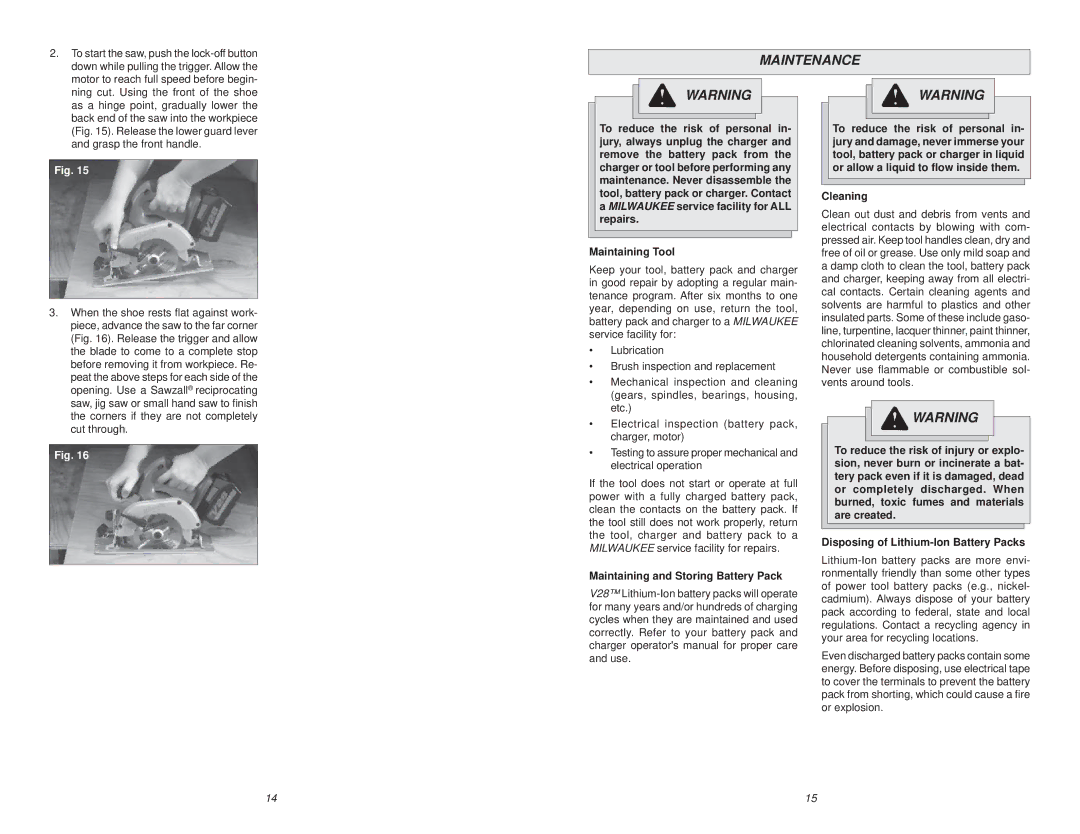
2. To start the saw, push the |
down while pulling the trigger. Allow the |
motor to reach full speed before begin- |
MAINTENANCE
ning cut. Using the front of the shoe |
as a hinge point, gradually lower the |
back end of the saw into the workpiece |
(Fig. 15). Release the lower guard lever |
and grasp the front handle. |
Fig. 15
3.When the shoe rests flat against work- piece, advance the saw to the far corner (Fig. 16). Release the trigger and allow the blade to come to a complete stop before removing it from workpiece. Re- peat the above steps for each side of the opening. Use a Sawzall® reciprocating saw, jig saw or small hand saw to finish the corners if they are not completely cut through.
Fig. 16
WARNING
To reduce the risk of personal in- jury, always unplug the charger and remove the battery pack from the charger or tool before performing any maintenance. Never disassemble the tool, battery pack or charger. Contact a MILWAUKEE service facility for ALL repairs.
Maintaining Tool
Keep your tool, battery pack and charger in good repair by adopting a regular main- tenance program. After six months to one year, depending on use, return the tool, battery pack and charger to a MILWAUKEE service facility for:
•Lubrication
•Brush inspection and replacement
•Mechanical inspection and cleaning (gears, spindles, bearings, housing, etc.)
•Electrical inspection (battery pack, charger, motor)
•Testing to assure proper mechanical and electrical operation
If the tool does not start or operate at full power with a fully charged battery pack, clean the contacts on the battery pack. If the tool still does not work properly, return the tool, charger and battery pack to a MILWAUKEE service facility for repairs.
Maintaining and Storing Battery Pack
V28™
WARNING
To reduce the risk of personal in- jury and damage, never immerse your tool, battery pack or charger in liquid or allow a liquid to flow inside them.
Cleaning
Clean out dust and debris from vents and electrical contacts by blowing with com- pressed air. Keep tool handles clean, dry and free of oil or grease. Use only mild soap and a damp cloth to clean the tool, battery pack and charger, keeping away from all electri- cal contacts. Certain cleaning agents and solvents are harmful to plastics and other insulated parts. Some of these include gaso- line, turpentine, lacquer thinner, paint thinner, chlorinated cleaning solvents, ammonia and household detergents containing ammonia. Never use flammable or combustible sol- vents around tools.
![]() WARNING
WARNING
To reduce the risk of injury or explo- sion, never burn or incinerate a bat- tery pack even if it is damaged, dead or completely discharged. When burned, toxic fumes and materials are created.
Disposing of
Even discharged battery packs contain some energy. Before disposing, use electrical tape to cover the terminals to prevent the battery pack from shorting, which could cause a fire or explosion.
14 | 15 |
